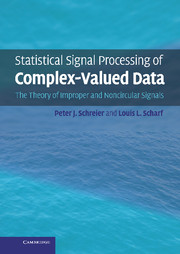Book contents
- Frontmatter
- Contents
- Preface
- Notation
- Part I Introduction
- Part II Complex random vectors
- 3 Second-order description of complex random vectors
- 4 Correlation analysis
- 5 Estimation
- 6 Performance bounds for parameter estimation
- 7 Detection
- Part III Complex random processes
- Appendix 1 Rudiments of matrix analysis
- Appendix 2 Complex differential calculus (Wirtinger calculus)
- Appendix 3 Introduction to majorization
- References
- Index
6 - Performance bounds for parameter estimation
from Part II - Complex random vectors
Published online by Cambridge University Press: 25 January 2011
- Frontmatter
- Contents
- Preface
- Notation
- Part I Introduction
- Part II Complex random vectors
- 3 Second-order description of complex random vectors
- 4 Correlation analysis
- 5 Estimation
- 6 Performance bounds for parameter estimation
- 7 Detection
- Part III Complex random processes
- Appendix 1 Rudiments of matrix analysis
- Appendix 2 Complex differential calculus (Wirtinger calculus)
- Appendix 3 Introduction to majorization
- References
- Index
Summary
All parameter estimation begins with a measurement and an algorithm for extracting a parameter estimate from the measurement. The algorithm is the estimator.
There are two ways to think about performance analysis. One way is to begin with a particular estimator and then to compute its performance. Typically this would amount to computing the bias of the estimator and its error covariance matrix. The practitioner then draws or analyzes concentration ellipsoids to decide whether or not the estimator meets specifications. But the other, more general, way is to establish a limit on the accuracy of any estimator of the parameter. We might call this a uniform limit, uniform over an entire class of estimators. Such a limit would speak to the information that the measurement carries about the underlying parameter, independently of how the information is extracted.
Performance bounds are fundamental to signal processing because they tell us when the number and quality of spatial, temporal, or spatial–temporal measurements is sufficient to meet performance specifications. That is, these general bounds speak to the quality of the experiment or the sensing schema itself, rather than to the subsequent signal processing. If the sensing scheme carries insufficient information about the underlying parameter, then no amount of sophisticated signal processing can extract information that is not there. In other words, if the bound says that the error covariance is larger than specifications require, then the experiment or measurement scheme must be redesigned.
- Type
- Chapter
- Information
- Statistical Signal Processing of Complex-Valued DataThe Theory of Improper and Noncircular Signals, pp. 151 - 176Publisher: Cambridge University PressPrint publication year: 2010



